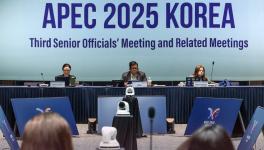Post-Cold War Era Barely Lasted 1144 Days

(‘End of Cold War’ monument in Malta marking Bush-Gorbachev summit, Dec 3, 1989)
The Saturday, December 3, 1989, when the Malta Summit took place between US President George HW Bush and Soviet President Mikhail Gorbachev, was a cold and Gothic night. So much so that the second round of talks followed by dinner had to be cancelled. A savage storm with fierce winds gusting above 70 kilometres per hour prevented Bush from leaving Belknap, the American cruiser anchored in Marsaxlokk Bay on Malta’s south coast, for the venue of the summit aboard the Soviet cruiser Slava anchored just 400 yards away. Bush wanted to go but couldn’t. The White House waited until the last minute, then canceled: no talks, no dinner.
The Malta Summit is deemed to haveofficially ended the Cold War. But Mother Nature knew there was nothing much to celebrate and that Russian-American tensions would resume. In the event, the post-cold war era lasted barely 1144 days. It conclusively ended with US President Donald Trump’s decision to suspend w.e.f February 2 the Intermediate-Range Nuclear Force (INF) Treaty, which had provided a key underpinning to the negotiated end to the Cold War.
The Russian Foreign Ministrystatement on February 2, was not far off the mark in saying that the US decision delivered a “crushing blow at the arms control system that took decades of painstaking efforts to create. This move will certainly have dramatic and far-flung consequences for the entire architecture of international security and strategic stability, primarily in Europe.”
These are early days, but the “dramatic and far-flung consequences” are already straining to surface. Their contours have appeared so far in three dimensions. First, the Russian retaliation has been swift and decisive.
At a meeting in the Kremlin on February 2 with the Russian foreign and defence ministers Sergey Lavrov and Sergei Shoigu, President Putin announced that the Russian response will be “symmetrical.” He gave the green signal to theDefence Ministry’s proposals tocreate aland-based version ofthe Kalibr launchers andto work onanew project todevelop aland-based hypersonic intermediate-range missile. Putin said Russia did not propose to initiate talks with the US but remained “ready toengage inequal andmeaningful dialogue.” Finally, he added that Russia will not unilaterally deploy intermediate-range orshorter-range weapons “until US weapons ofthis kind are deployed tothecorresponding regions oftheworld.” (Transcript)
Clearly, no matter the public stance by Washington and Moscow, an arms race has begun. In fact, by February 5, Defence Minister Shoigu already disclosed that the two specific proposals approved by Putin three days ago are under implementation and the target has been set that by next year Russia will have developed the ground-based version of the sea-launched Kalibr system (that is, the long-range cruise missile) and created a ground-based long-range hypersonic missile system. Shoigu described the new systems as “tit-for-tat mirrored measures.”
Second, Russian foreign ministrystated on February 4that Moscow intends to hold NATO responsible as well for the “destruction” of the INF Treaty. That is to say, Moscow regards the NATO deployment of components of the US missile defence system in Europe – the Mk-41 missile launchers that are deployed to Romania and are planned to be deployed to Poland next year – as “in breach of the INF Treaty.”
This is smart thinking – especially, coupled with Putin’s assurance that Russia will deploy intermediate range missiles only in response to US deployments. Evidently, Moscow has not given up hopes that a strong European opinion militating against deployments of the US ABM system may still surface — although as of today the Trump administration has been rather successful in rallying its NATO allies behind its decision to exit the INF Treaty.
The coming months will tell whether Moscow’s hopes are justified or not. Conceivably, the Russian decision to link NATO deployments of the ABM system with the INF Treaty will nonetheless pose a strategic dilemma to European countries. Poland, for instance, will now have to think hard about the proposed deployment of US launchers next year. On the other hand, by brining NATO into the equation, Moscow now gets a free hand to respond to the alliance’s force projection in Central Europe and the Baltics.
Third, stemming from the above, the big question remains: Where is it that the US intends to deploy its newly developed intermediate range missiles — Europe or Asia? The Russian experts seem to think that the likelihood is that the US deployments may take place in Japan or South Korea.
Indeed, Trump has mentioned China more than once as having missile capability that threatens the US and its allies. Arguably, the US decision to abandon the INF Treaty would have been significantly motivated by the perceived need to bring China into the ambit of the arms control regime.
Having said that, there is also an intriguing point of view that the US and Russia would have a common interest in getting China involved in arms control negotiations. The Deutsche Welle’s Berlin bureau chief Max Hofmannwrote last week,
“The US and Russia… would be happy to see China bound by a new arms treaty — it is not party to any such agreement, and has been building up its military in recent years. Russia in particular feels threatened by its neighbor’s military advances, which is why it is relying on land-based, medium-range missiles to project military might towards the Middle Kingdom… But while Russia can credibly claim to feel threatened by China, it is entirely unclear why it is also aiming its medium-range missiles at Europe.”
Indeed, the striking thing is that behind the cloud cover of rhetoric and posturing, both Washington and Moscow may be feeling relieved that they are no longer bound by the restrictions put on them by the INF Treaty. Ironically, the INF Treaty is a legacy of the “bipolar” world order, which no longer exists. The list of countries with missile capability is steadily growing. China, India and Iran are only the most glaring examples. Trump has been candid in asking why the US should put itself at a disadvantage by the INF Treaty.
However, the likelihood of China agreeing to come within the purview of anything like the INF Treaty is remote. The point is, something like 90% of China’s missile stockpile consist of intermediate range missiles and any curb on them would mean Beijing agreeing to scuttle its missile development program itself, which is of course too much to expect.
Significantly, the Chinese communist party tabloid Global Times said in aneditorial commentlast week,
“China’s nuclear deterrence isn’t comparable to that of the US and Russia. Portraying China’s military development as part of an “arms race,” the US is creating an excuse to suppress China’s legitimate build-up of its national defense… As far as China is concerned, the US intends to make the INF treaty a multilateral agreement, which may become an excuse for Washington to exert pressure on Beijing. Without the restraints of the treaty, the US may intensify its deployment of offensive missiles and anti-missile systems around China, further increasing China’s strategic security challenges.”
“Beijing will never accept the (INF) treaty becoming a multilateral agreement. It must reject any request from the US on the issue. Instead of relying too much on land-based missiles for national security, China must diversify its strategic nuclear deterrence. It’s an urgent task.”
The editorial warned that China will be forced into a reassessment of security risks and a redefinition of the concept of security, which has implications for international relations as a whole. The daily gently flagged that such a scenario may even turn out to be“unfavourable” for therevolution of the North Korean issue.
Get the latest reports & analysis with people's perspective on Protests, movements & deep analytical videos, discussions of the current affairs in your Telegram app. Subscribe to NewsClick's Telegram channel & get Real-Time updates on stories, as they get published on our website.























